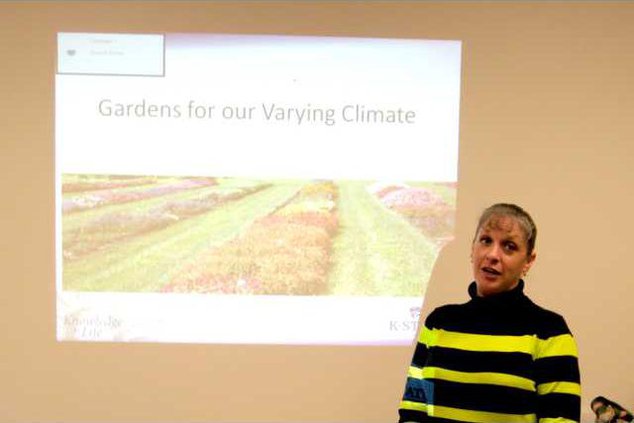At a recent Great Bend Garden Club meeting, Alicia Boor, the agriculture and natural resources agent for the Barton County Extension Service, presented an informative program entitled “Gardens for our Varying Climate.” Armed with data from Kansas State University’s Agricultural Research and Extension Services, Boor first described the serious lack of water facing many parts of the state and what is currently being done to help prevent the very probable water crisis that faces the whole state in the future. Although watering of gardens is only a small segment of the increasing water problem, Boor brought a wealth of information and suggestions on how individuals who enjoy the luxury of flower gardening and maintaining trees, shrubs, and green lawns can plan and design a more ecologically sound outdoor landscape. The process is called Xeriscaping (zer-i-skaping) as opposed to Zero-scaping, currently practiced in the desert climate of the Southwest. Xeriscaping is the use of plants which, by their growth requirements and placement in the landscape, will require very little watering.
Boor stressed the importance of planning and designing with plant selection and placement taking into account the results of soil tests and soil preparation, ground slope, possible natural water sources, mulching, and the grouping of plants. Testing programs are continually being conducted by K-State experimental farms to determine which plants and grasses can survive the wind and the heat tolerant zones (7&8) and cold hardiness zones (6&7) of Kansas. Information gathered has been compiled into lists of plants that have successfully survived for two full growing seasons throughout the state.
There are lists of drought tolerant trees, shrubs, ground cover, ornamental grasses, herbs, and sods. There are lists from two projects called Prairie Star which recommends specific varieties of annual flowers and Prairie Bloom which recommends specific varieties of perennial blooms. These specifically identified specimens have all demonstrated not only the two year survival rate, but also a beautiful show of blossoms. All of this information is continually updated and can be obtained by visiting the university’s website: www.prairiestarflowers.com or visiting the Barton County Extension Office.
During the business meeting, President Nancy Swafford thanked Becky Dudrey for the program arrangements and Fern Tompkins for furnishing a cookie assortment and candies for refreshments. Thirteen members answered roll call and a treasurer’s report was given by Fern Tompkins. Mary Kummer reported on her inquiries regarding possible trellises or arbors for the Great Bend Cemetery Rose Garden and it was decided to purchase a trellis to complete the backdrop area of the garden. It was decided to keep the remaining birdbath in the center of the garden for a period of time. Delores Grose reported two additional names for the memorial plaques. Alice Young reported that Andrea Maxwell from Great Bend High School will again provide between four and five students to work cleaning out the rose beds during the high school’s Community Work day on April 24th.
The next Garden Club meeting will be at 10 a.m. on April 16 in the Barton County Extension meeting room. Darlene Boley will provide the program and Delores Grose will be the hostess.
Xeriscaping encouraged at Garden Club meeting




